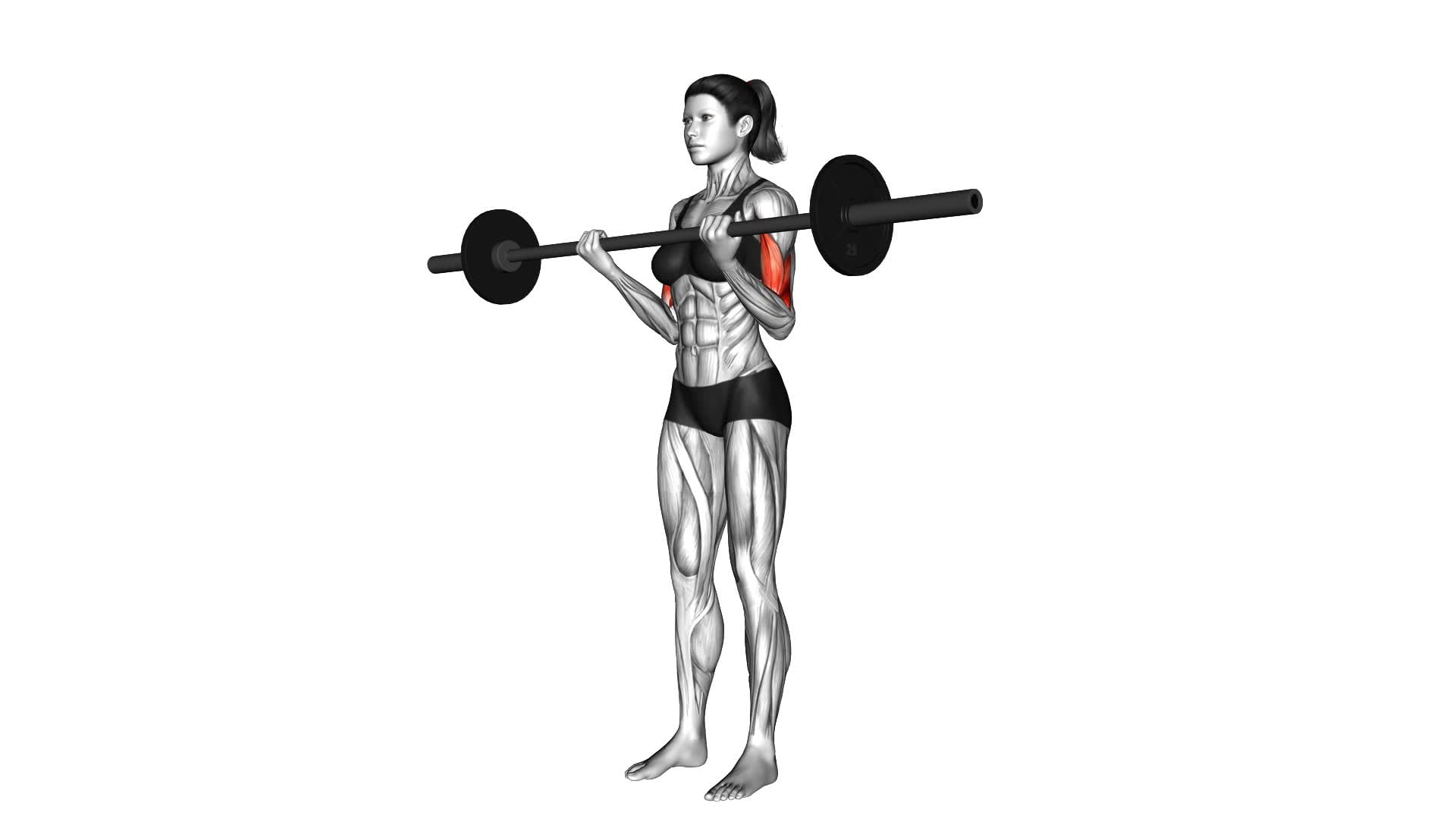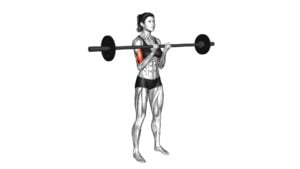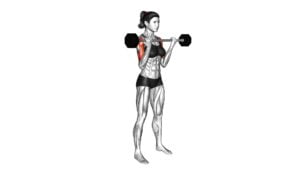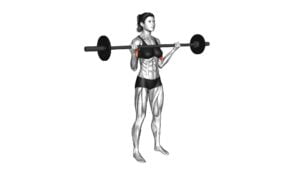Barbell Curl (female) – Video Exercise Guide & Tips

Are you a woman looking to strengthen and tone your arms? Look no further than the barbell curl!
Watch This Exercise Video
In this video exercise guide, we'll walk you through the proper form and technique for this effective upper body exercise. You'll also learn how to choose the right weight and avoid common mistakes.
With variations and modifications to suit your fitness level, our tips will help you achieve maximum results.
Get ready to feel the burn with the barbell curl!
Key Takeaways
- Barbell curl targets biceps, forearms, and shoulders for a comprehensive upper body workout.
- Proper form and technique include standing with feet shoulder-width apart, holding the barbell with an underhand grip, and lifting it towards the chest while keeping the upper arms close to the sides.
- Choosing the right weight is important, starting with a manageable weight and gradually increasing it to continue challenging the muscles.
- Progressively increasing weight using methods like the pyramid method or double progression helps promote muscle growth and strength development.
Benefits of Barbell Curl for Women
You should regularly incorporate barbell curls into your workout routine as a woman because they offer numerous benefits for your strength and muscle development. Barbell curls specifically target your biceps, helping to build and define these muscles. As a woman, you might consider incorporating female-specific barbell curl modifications to ensure that you're working within a comfortable range of motion and avoiding any unnecessary strain. These modifications can include using lighter weights, adjusting your grip width, or using an EZ curl bar.
In addition to targeting your biceps, barbell curls also engage your forearms and shoulders, providing a comprehensive upper body workout. By incorporating barbell curls into a full body workout routine, you can enhance your overall strength and muscle tone. This exercise can be easily added to your routine, either as a standalone exercise or as part of a superset or circuit.
By regularly performing barbell curls, you can improve your functional strength, making everyday tasks easier and reducing your risk of injury. Additionally, stronger biceps can enhance your performance in other exercises, such as pull-ups or rows.
Now that you understand the benefits of incorporating barbell curls into your workout routine, it's important to focus on proper form and technique to maximize your results.
Proper Form and Technique for Barbell Curl
To perform the barbell curl with proper form and technique, focus on maintaining a strong and stable position throughout the exercise. Here are four important tips to help you maximize the benefits of the barbell curl and explore different variations:
- Start by standing with your feet shoulder-width apart and your knees slightly bent. Keep your core engaged and your back straight throughout the movement.
- Hold the barbell with an underhand grip, palms facing up. Your hands should be slightly wider than shoulder-width apart. Keep your wrists straight and avoid excessive bending or flexing.
- Slowly lift the barbell towards your chest, keeping your upper arms close to your sides. As you curl, focus on contracting your biceps and squeezing them at the top of the movement.
- Lower the barbell back down to the starting position in a controlled manner, maintaining tension in your biceps. Avoid using momentum or swinging your body to complete the rep.
Choosing the Right Weight for Barbell Curl
When choosing the right weight for barbell curls, it's important to start with a weight that's manageable for beginners. Begin with a weight that allows you to perform the exercise with proper form and technique.
As you become more comfortable and stronger, progressively increase the weight to continue challenging your muscles and promoting growth.
Weight for Beginners
For beginners, selecting the appropriate weight for the barbell curl is crucial for achieving optimal results. Here are four key factors to consider when choosing the right weight for your barbell curl:
- Start with a lighter weight: As a beginner, it's important to start with a weight that challenges you but is manageable. This will allow you to focus on maintaining proper form and technique.
- Gradually increase the weight: As you become more comfortable with the exercise, gradually increase the weight to continue challenging your muscles. This progressive overload is essential for muscle growth and strength development.
- Listen to your body: Pay attention to how your body feels during the exercise. If the weight feels too heavy and compromises your form, reduce the weight. It's better to prioritize proper technique over lifting heavy weights.
- Seek guidance: If you're unsure about the appropriate weight for your barbell curl, don't hesitate to seek guidance from a qualified fitness professional. They can assess your strength and help you determine the right starting point.
By selecting the right weight and gradually increasing it, you can effectively progress and achieve your desired results in your barbell curl routine.
Now, let's move on to the next section about progressively increasing weight.
Progressively Increasing Weight
As you progress in your barbell curl routine, it's important to gradually increase the weight to continue challenging your muscles and promote muscle growth and strength development. Increasing the intensity of your workouts is key to seeing progress and preventing plateaus.
One of the advanced techniques you can use to progressively increase weight is called the pyramid method. This involves starting with a lighter weight and performing a higher number of repetitions, then gradually increasing the weight and decreasing the number of repetitions with each set.
Another technique is called the double progression method, where you keep the weight constant for a certain number of sets and only increase it once you can perform the desired number of repetitions with good form.
Both of these techniques allow you to gradually increase the weight over time, ensuring that your muscles are consistently challenged and promoting continuous growth and strength development.
Common Mistakes to Avoid During Barbell Curl
When performing the barbell curl, it's important to avoid common mistakes that can hinder your progress and potentially lead to injury.
Firstly, make sure to maintain proper wrist positioning throughout the exercise, keeping your wrists straight and aligned with your forearms.
Secondly, avoid using momentum to lift the weight, as this takes away from the effectiveness of the exercise and puts unnecessary strain on your muscles.
Lastly, don't neglect the full range of motion by only partially extending or flexing your arms, as this limits the benefits of the exercise.
Improper Wrist Positioning
To avoid improper wrist positioning during the barbell curl, make sure to keep your wrists straight and aligned with your forearms. This is crucial for injury prevention and to maintain proper wrist mobility throughout the exercise. Here are some tips to help you maintain the correct wrist position:
- Grip the barbell with an overhand grip, keeping your hands shoulder-width apart.
- Position your hands so that your palms are facing forward and your thumbs are wrapped around the bar.
- As you lift the barbell, avoid bending or flexing your wrists. Keep them in line with your forearms throughout the movement.
- Engage your forearm muscles to support your wrists and maintain stability.
By following these guidelines, you can ensure that your wrists are properly positioned during the barbell curl, reducing the risk of injury and maximizing the effectiveness of the exercise.
Now let's move on to the next section about using momentum to lift.
Using Momentum to Lift
To avoid using momentum to lift during the barbell curl, keep your movements controlled and focus on engaging your target muscles. Using momentum to lift the weight not only reduces the effectiveness of the exercise, but it also increases the risk of injury.
When you swing the barbell up using momentum, you aren't fully engaging the biceps, which is the primary muscle being targeted in this exercise. This can lead to imbalances and decreased muscle growth. Additionally, using momentum puts unnecessary strain on your joints and tendons, increasing the risk of strains or tears.
To avoid injury and maximize the benefits of the barbell curl, perform the exercise in a slow and controlled manner, focusing on the contraction of your biceps throughout the entire range of motion. By doing so, you'll ensure that you're getting the most out of each repetition while reducing the risk of injury.
Now, let's move on to the next common mistake: neglecting full range.
Neglecting Full Range
To prevent neglecting the full range during the barbell curl, focus on maintaining controlled movements and engaging your target muscles throughout the exercise. Neglecting the full range of motion can limit the benefits you receive from this exercise.
Here are some proper technique tips to help you maximize the full range benefits:
- Start with your arms fully extended, allowing the barbell to hang at your thighs.
- As you curl the barbell up towards your chest, make sure to fully contract your biceps.
- Avoid swinging or using momentum to lift the weight. This can cheat your muscles and reduce the effectiveness of the exercise.
- Lower the weight back down slowly and in a controlled manner, fully extending your arms again.
Variations and Modifications for Barbell Curl
Choose from five variations and modifications to enhance your barbell curl routine. These variations and modifications can help you target different muscles, add intensity to your workout, and prevent plateaus.
- Close Grip Barbell Curl: This variation involves holding the barbell with your hands closer together, which places more emphasis on the biceps brachii. It's a great way to target the inner part of your biceps and develop forearm strength.
- Wide Grip Barbell Curl: In this variation, you hold the barbell with your hands wider apart. This targets the outer part of your biceps and helps improve overall bicep width and thickness.
- Reverse Grip Barbell Curl: Instead of holding the barbell with an overhand grip, you grip it underhand. This variation targets the brachialis muscle, which lies underneath the biceps brachii. It helps add thickness and creates a more well-rounded look to your arms.
- Preacher Curl: This modification involves using a preacher curl bench or an incline bench to support your arms as you perform the curl. It isolates the biceps and reduces the involvement of other muscles, allowing for a more focused workout.
- Zottman Curl: This modification combines a regular barbell curl with a reverse grip curl. Start with an underhand grip, curl the barbell up, then rotate your wrists and lower the barbell with an overhand grip. This variation targets both the biceps and forearms, providing a comprehensive arm workout.
Incorporating these variations and modifications into your barbell curl routine can help you achieve better results and prevent boredom. Remember to start with lighter weights and gradually increase the intensity as you become more comfortable with each variation.
Tips for Achieving Maximum Results With Barbell Curl
To maximize your results with the barbell curl, focus on achieving proper form and gradually increasing the weight to challenge your muscles. Proper form is crucial to ensure that you're targeting the right muscles and minimizing the risk of injury.
Here are some tips to help you achieve maximum results with the barbell curl:
- Maintain a neutral spine: Keep your back straight throughout the exercise and avoid arching or rounding your back. This will help you engage your biceps effectively and prevent strain on your lower back.
- Control the movement: Avoid using momentum to lift the weight. Instead, focus on controlled and deliberate movements, both on the way up and on the way down. This will provide maximum tension to your biceps and lead to better muscle activation.
- Avoid excessive swinging: Swinging the barbell can reduce the effectiveness of the exercise and put unnecessary strain on your joints. Keep your upper body stable and use only your biceps to lift the weight.
- Don't rush the exercise: Take your time and perform the barbell curl with a slow and controlled tempo. This will ensure that your muscles are fully engaged throughout the movement and maximize the results.
Frequently Asked Questions
Can Barbell Curls Help Me Lose Weight?
Barbell curls are a great exercise for toning and strengthening your arm muscles. While they won't directly help you lose weight, they can contribute to an overall calorie burn and help you build lean muscle mass.
The proper barbell curl form is important to maximize the benefits and prevent injury. For women, barbell curls can improve upper body strength and enhance your overall physique.
How Often Should I Incorporate Barbell Curls Into My Workout Routine?
To effectively incorporate barbell curls into your workout routine, it's important to consider a few factors.
First, try incorporating other bicep exercises to target the muscles from different angles. This can help improve overall muscle development.
Additionally, varying your rep ranges can provide different benefits, such as building strength or increasing muscle endurance.
It's recommended to perform barbell curls 2-3 times a week, allowing for adequate rest and recovery between sessions.
Are There Any Alternative Exercises That Can Target the Same Muscles as Barbell Curls?
If you're looking for alternative exercises that target the same muscles as barbell curls, there are a few options to consider.
One option is dumbbell curls, which work the biceps in a similar way.
Another option is the hammer curl, which targets both the biceps and forearms.
Additionally, cable curls and resistance band curls are effective alternatives that provide a different type of resistance.
These exercises can help you achieve your muscle targeting goals while adding variety to your workout routine.
Can Barbell Curls Help Improve My Posture?
Barbell curls can indeed help improve your posture by strengthening your back muscles and correcting rounded shoulders. By targeting the biceps, forearms, and upper back, barbell curls engage and strengthen the muscles responsible for maintaining an upright posture.
When performed correctly, with proper form and technique, barbell curls can be an effective exercise for improving back strength and promoting better posture overall. Remember to start with a weight that challenges you but allows for proper form.
Is It Necessary to Use a Spotter When Performing Barbell Curls?
When performing barbell curls, it's important to consider whether or not you need a spotter. While a spotter isn't necessary for everyone, having one can provide added safety and support.
A spotter's role is to assist you in case you struggle with the weight or lose control. This can prevent injuries and allow you to push yourself beyond your limits.
Conclusion
Overall, the barbell curl is a highly effective exercise for women looking to strengthen and tone their biceps. By following proper form and technique, choosing the right weight, and avoiding common mistakes, you can maximize your results.
Additionally, incorporating variations and modifications can add variety to your workouts and target different muscle groups.
Remember to always consult with a fitness professional to ensure you're performing the exercise correctly and safely.
Keep pushing yourself and enjoy the benefits of the barbell curl!

Author
Years ago, the spark of my life’s passion ignited in my mind the moment I stepped into the local gym for the first time. The inaugural bead of perspiration, the initial endeavor, the very first surge of endorphins, and a sense of pride that washed over me post-workout marked the beginning of my deep-seated interest in strength sports, fitness, and sports nutrition. This very curiosity blossomed rapidly into a profound fascination, propelling me to earn a Master’s degree in Physical Education from the Academy of Physical Education in Krakow, followed by a Sports Manager diploma from the Jagiellonian University. My journey of growth led me to gain more specialized qualifications, such as being a certified personal trainer with a focus on sports dietetics, a lifeguard, and an instructor for wellness and corrective gymnastics. Theoretical knowledge paired seamlessly with practical experience, reinforcing my belief that the transformation of individuals under my guidance was also a reflection of my personal growth. This belief holds true even today. Each day, I strive to push the boundaries and explore new realms. These realms gently elevate me to greater heights. The unique combination of passion for my field and the continuous quest for growth fuels my drive to break new ground.



